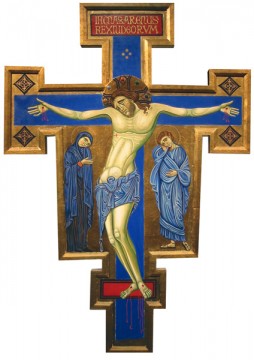History of The Blue Cross
This Blue Cross is an important Cross in the tradition of the Franciscans. To understand the importance, we need to reflect on God’s calling of St. Francis of Assisi. Upon hearing the Call to “rebuild my house,” while in prayer before the Cross of San Damiano, Saint Francis of Assisi began his life’s conversion. However, his response to that Call is reflected through a different cross. Commissioned for the Lower Church of the Basilica Papale e Sacro Convento di San Francesco (Papal Basilica and Sacred Convent of St. Francis), in the mid 1200’s, it is thought that the “Blue Cross” was suspended over the altar at the Tomb of St. Francis. This crucifix is one of a pair created by the “Maestro dei Crocifissi Blu” (Master of the Blue Crucifix), who used blue pigment as a reoccurring element in his work. The other is in the Wallraf-Richartz-Museum in Cologne. The Blue Cross, now located in the Museo del Tesoro (basilica museum), is the artistic representation of the Franciscan answer to God’s Call.
When you visit Assisi, Italy, you can find the San Damiano crucifix in the Basilica of St. Clare. The Poor Clare Sisters moved the cross from San Domiano Church when they moved their Monastery to the Basilica which served as tomb for the body of St. Clare.
The experience of the Cross speaking to Francis was an essential moment in the beginnings of the conversion of St. Francis. God continued to call St. Francis to a much deeper conversion. The Blue Cross represents the response of St. Francis to the call of God in his life. In reflecting upon the themes of the Blue Cross, you grow in an understanding of the Gospel of John, the preaching of St. Francis, and love that God truly has for you.
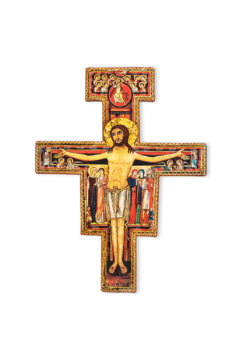
The Blue Cross at Our Lady of Guadalupe
Our Blue Cross was prepared (painted) in the tradition of an Icon. Our artist, Jean Schettler, prepared herself for this work of God through fasting and prayer. She and the Cross were anointed and the community gathered around her and prayed for her. Our artist used to live in the Torrance area and now lives in the Louisville, Kentucky area. She was commissioned to paint the cross by Fr. David Kocka, who studied with Father Ray.
“It took me a long time to get my head wrapped around it ⎯ that I was doing it and what it would mean to people in the church,” Schettler said. “I am proud of the work.”
Our Cross is nearly 7 foot by 6 foot. It is oil on wood and is one of the most significant focal points in our Church. We hope that it will help lead us to prayer and reflection upon the mystery of the Holy Trinity especially the mystery of God becoming incarnate.
Father Ray explains that many people think the San Damiano cross is the Franciscan cross. This crucifix is known as the “Cross of the Call” because God spoke through it when calling on St. Francis to rebuild his church.
“The Blue Cross is the ‘Cross of the Response’ that the friars commissioned to place over St. Francis’ tomb. In understanding the Blue Cross, one begins to understand the meaning of the life of St. Francis ⎯ our call to repent, our ongoing conversion to Christ.
The color blue symbolizes the humanity of Jesus Christ. The Cross is predominantly blue to signify that God became man and died for us because He truly loves us. Father Ray explains, “In the times we live in, this speaks volumes because we need hope, and hope can be found in Christ. It’s rich in meaning.”
The Blue Cross was installed in our church during the remodeling project in 2008.
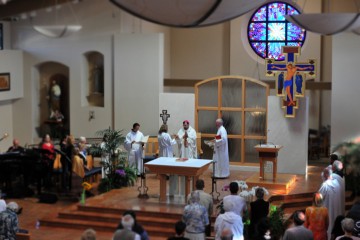
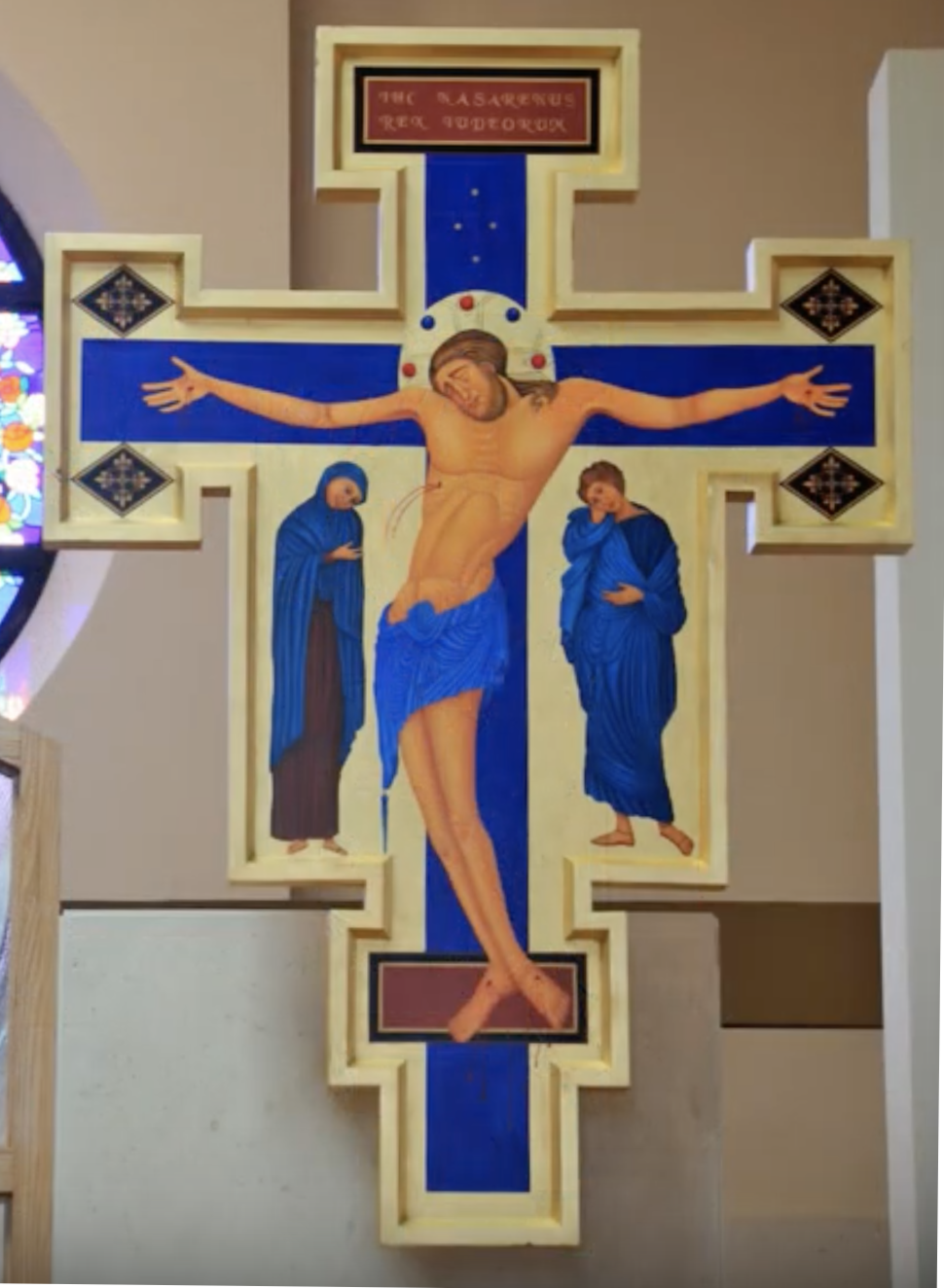
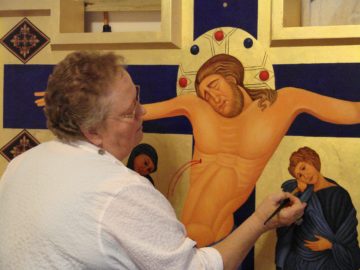
Additional Information about the Blue Cross
The Cross of the Response
After Francis heard the voice of Christ speak to him on that autumn day, “go and rebuild my house…,” he never mentions the Cross of San Damiano again in any of his writings. Yet the words of Christ never left Francis’ heart, and his personal response never faltered. He went forth to see the glorified Christ in every crucified person – especially in the poor, the dispossessed, and the leper. What Francis effected by the acceptance of his calling was not the sweet and lyrical movement that later poets describe. Rather, it was a gritty grassroots spiritual campaign that transformed the vestiges of a distanced, glorified medieval king into the visible footprints of an imminent Renaissance Saviour.
While Francis was called to passionate conversion by the San Damiano Cross, his response to that call was chronicled in a completely different cross. The “Blue Cross” was commissioned for the lower basilica in Assisi (c.1250), and was probably suspended over the altar of Saint Francis’ tomb. Now located in the basilica museum, this cross was the early community’s artistic representation of the founder’s free response to the call of the San Damiano Christ. The Blue Cross, along with all of the prototypical art frescoed in the basilica (cf. chap. 6), presented the Franciscan vision of God.
Even though the Middle Ages were 1200 years beyond the Resurrection, the Franciscan movement was restating that the God of paradoxes had been born, died and was resurrected. Everything in the old order had been reversed by the new order; no longer was the law an “eye for an eye,” but now one must “turn the other cheek.” The Lord of armies and the Lord of hosts had become the Lord of shepherds, tax collectors, and prostitutes. In the midst of the awakened realization of these profound spiritual reversals, the art conventions (that had always been used to set theology free from the abstract) were also being renewed and changed.
Painting Style
The style of painting before the Franciscan movement was greatly influenced by the Eastern Empire. Byzantine iconographers followed a strict code of color symbolism whereby blue was used to represent divinity while red represented humanity. The San Damiano Cross, a Syrian icon, has a predominance of the color red. Even though Jesus dies in his humanity, here he is portrayed in his divinity as the glorified Christ, totally in control of the situation. In sharp contrast, the Blue Cross presents Christ as completely at the mercy of the external elements. Blood spills from his side. He is not resurrected, he is dead. Yet the phrase Rex Glorie (“The King of Glory”) boldly appears on the reverse side of this two-sided crucifix.
At first the medieval viewer may have been confused by what appears to be a contradiction between the image itself and the words used to describe it. However, the plainness of the Blue Cross, as compared to the busyness of the San Damiano, answers the medieval quandary. This Christ speaks one simple truth, one simple message: this is true glory, to give one’s life for another.
With the previous emphasis on divinity, the people felt distanced from a Christ who had already fulfilled his destiny, who had already passed beyond all suffering and was looking down upon their misery from the heights of heavenly glory. The genius of the Franciscan movement, beginning with this image, was to portray Christ as suffering. Christ died once for all, but he continues to feel the pain of our nails, our crosses and our deaths. Christ is found not in the heights of heavenly glory but in the glorified depths of sacrificial love.
Cross Details
In the Blue Cross, Christ is not like a man, Christ is a man. The loincloth which was a neatly pleated liturgical garment on the figure of Christ in the San Damiano Cross has now become a banner, a flag highlighting Christ’s manhood. The rehumanization-of-the-divine theme of the Franciscan movement empowered the Renaissance to emphasize the maleness of Christ as the preeminent manner of expressing a new found goodness in being human.
The Virgin Mary and John the Apostle are standing at the foot of the cross. They are plainly figured. They are obviously saddened, pondering what they cannot bear to see. The John and Mary of the Blue Cross are not like the John and Mary of the San Damiano Cross. Here these two holy people are not yet rejoicing in the resurrection because they still feel the agony of Jesus’ death. The John and Mary of the Blue Cross are looking at the viewer but pointing to Christ. They stand as firm witnesses that Jesus Christ was truly a man who had endured a torturous crucifixion and had died. He was not merely pretending to die on the cross as several of the heresies of the Middle Ages believed. Our God loved us so much that he suffered with us in our humanity. A mystery of love which will ever remain a mystery to logic.

